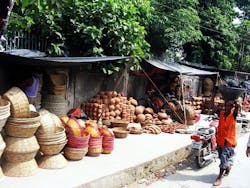What to Make of this Curious Headline from India: Solar Microgrid Not ‘Real’ Electricity?
Credit: Manoj nav
I was struck this week by a curious headline about a new solar microgrid in India, ‘Bihar village rejects solar-powered microgrid and demands ‘real’ electricity.’
The India Today article tells the story of Dharnai, “a non-descript village tucked away in the Naxal heartland of Bihar.” The village recently gained electricity for the first time in 33 years thanks to a 100-kW solar microgrid brought by Greenpeace India.
But apparently not all of the villagers are happy with the microgrid.
“Village youngsters” greeted a visiting dignitary with placards that said: “We do not want artificial energy, give us the real one,” said the article.
It is not clear from the article why the protesters considered the solar microgrid artificial energy; nor is it clear how they they define real energy. But the article implied that they wanted their village to be connected to the main grid, as it had been more than 30 years earlier before a transformer burned and cables were carted away.
Clearly, the protesters view microgrids very differently than do Americans. Here a microgrid is a premium product, likely to be employed by research universities, data centers and others seeking high quality, reliable power. These microgrids are very much ‘real’ electricity in that they reduce the threat of outages. “I see ourselves as at risk anytime we are on the grid because we are more reliable than them,” said Juan Ontiveros, who runs the microgrid at the University of Texas at Austin, when he was recently interviewed by MicrogridKnowledge.com. His statement encapsulated the growing appreciation of microgrids in the United States, especially since Superstorm Sandy.
But in Dharnai, the microgrid is viewed as a lesser product. Why?
When I tweeted my bewilderment about the Dharnai headline, I received a link to an interesting analysis that may shed some light. In Making Energy Access Meaningful, authors Morgan Bazlian and Roger Pielke argue that our efforts to electrify energy poor regions are too meager to make an economic dent. They wrote:
“…achieving minimal levels of energy access is not to be confused with success in achieving goals of modern energy access. The sorts of policies that would make sense to get large numbers of people over a low and arbitrary threshold are very different from those that will underpin sustained growth in economies and consumption. Consider that we do not label people who live on more than $1 per day as having “economic access” and address policies toward achieving a $1.25 level, thus still leaving them desperately poor. Everyone understands that $1.25 a day is still not nearly enough. In energy, we often lack such conceptual clarity…”
Is that what Dharnai’s protesters mean when they call for real energy? Are they arguing that the solar microgrid, while nice, won’t really change their economic prospects?
For its part, Greenpeace India has a lot of good things to say about Dharnai’s solar microgrid. It certainly sounds game changing – the microgrid, which includes battery storage for 24/7 power, will light up 50 shops, a bank, a school, a health facility, a training center, several agricultural water pumps, 60 street lights, and 450 households reaching 2,200 people.
Follow us on Twitter @MicrogridNews. Or join the Microgrid Knowledge conversation on LinkedIn.
Greenpeace volunteer Avik Roy tells a story in a blog about Suresh Manjhi, who will no longer have to travel more than three miles from Dharnai just to charge his cell phone or pay for expensive kerosene to see at night. Roy also quoted Dharnai resident Ranti Devi as saying, “We had a lot of problems in the past, but since the lights have been installed in our homes, it has become easier for us to cook and for our children to study. We can walk around in the streets at night without any fear.”
So what is the real story? Does the Dharnai microgrid represent a way out of poverty or false hope? I ask sincerely; I do not know and very much look forward to your comments on what microgrids mean to poor rural communities. Please speak up, especially our readers from northern India, as well as American microgrid developers who do business there. Your insight is needed.
About the Author
Elisa Wood
Editor-in-Chief
Elisa Wood is the editor and founder of EnergyChangemakers.com. She is co-founder and former editor of Microgrid Knowledge.
